Upgrading Web Equipment Pattern 1908 - Territorial Army
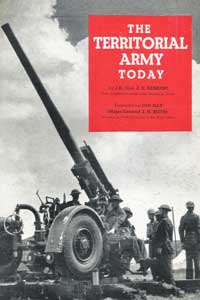
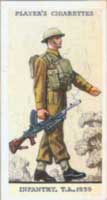 At left is a book, published in 1939 and inscribed by the author in May of that year. At right is Card No. 50 of Players’ Cigarettes series Uniforms of the Territorial Army, which was published in October 1939, showing a “Terrier” in Battle Dress, with a Bren Gun. The author of The Territorial Army Today was Col. J.K. Dunlop, who was the Assistant Adjutant-General of the Territorial Army, The Foreword was by Maj. Gen. J.H. Beith, W.O. Director of Public Relations, who was better known by the nom de plume of “Ian Hay”, author of The First 100,000 K1, the story of the First of Kitchener’s New Armies. Dunlop describes the many changes in organisation and equipment of the much modernised T.A.. The cigarette card was more by way of a Vision For The Future. Not one photo in Dunlop’s book shows soldiers in other than Service Dress and Patt. ’08 W.E.. However, they are shown with the latest Infantry weapons - Bren Gun, Boys Anti-Tank Rifle, 2-inch Mortar, together with 3-inch Mortar and the heavier equipment of the Anti-Aircraft, Searchlight, Field Force and Coast Defence units.
At left is a book, published in 1939 and inscribed by the author in May of that year. At right is Card No. 50 of Players’ Cigarettes series Uniforms of the Territorial Army, which was published in October 1939, showing a “Terrier” in Battle Dress, with a Bren Gun. The author of The Territorial Army Today was Col. J.K. Dunlop, who was the Assistant Adjutant-General of the Territorial Army, The Foreword was by Maj. Gen. J.H. Beith, W.O. Director of Public Relations, who was better known by the nom de plume of “Ian Hay”, author of The First 100,000 K1, the story of the First of Kitchener’s New Armies. Dunlop describes the many changes in organisation and equipment of the much modernised T.A.. The cigarette card was more by way of a Vision For The Future. Not one photo in Dunlop’s book shows soldiers in other than Service Dress and Patt. ’08 W.E.. However, they are shown with the latest Infantry weapons - Bren Gun, Boys Anti-Tank Rifle, 2-inch Mortar, together with 3-inch Mortar and the heavier equipment of the Anti-Aircraft, Searchlight, Field Force and Coast Defence units.
In the Autumn of 1936, the T.A. had a strength of just 135,000 against an establishment of 170,000. By January 1939, the T.A. was larger than the Regular Army. In March 1939, the T.A. had a strength of 212,000 officers and men, against an establishment of 228,989 – a rather precise figure! The Field Force – the Infantry element of the T.A. – was then 129,000, with Anti-Aircraft and Coast Defence accounting for a further 75,000 and 8,000 respectively, making up the 212,000 total. The author comments “…Since the last words in this book were written, the Prime Minister has announced…that the Territorial Field Army is to be doubled in establishment…”. Thus in March 1939, the T.A. had been authorised to almost treble their strength, from 129,000 to 340,000, of whom 100,000 would go to Anti-Aircraft Command. It should be emphasised that the “Terriers” were volunteers, so this massive increase in personnel was taking place alongside the conscription of men, which is described in the Introduction to the Pattern 1939 section of Karkee Web.
The Military Training Act was passed in April 1939, requiring all men, aged 20-21 to register and to undergo six months’ military training. At this time, the Regular Army totalled around 200,000 men. Superseding the Military Training Act, the National Service (Armed Forces) Act was passed by Parliament on 3rd September, 1939, the day war was declared. This required all males of 18 to 41 to register, conscription having been re-introduced by the Act. At the outbreak of war, the British Army had just under 900,000 men, inclusive of the T.A..
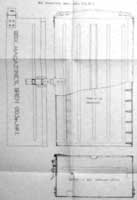 The T.A. was administered by County Territorial Associations, who received funds from the War Office, to cover uniforms, accoutrements and necessaries. Weapons were supplied by the War Office. By this time, most T.A. units had long been equipped with Pattern 1908 W.E.. The Regular Army were being re-equipped with Pattern 1937 W.E., a change occasioned by the adoption of the Bren Gun, whose magazines needed larger pouches. Since the T.A. were now being equipped with Bren Guns, the Patt. ’08 Cartridge carriers would not suffice. The new Infantry Section was made up of eight men, all of whom carried Bren magazines, plus 50 rounds in a Bandolier, cotton, 50 rounds. If the T.A. were to carry magazines, the Bren No. 2 would need to use the Box, magazines, Bren .303 in. M.G., Mark I. seen at right, in an extract from drawing D.D.(E) 1924. In 1939, the Infantry Section carried 24 magazines in their Basic pouches. Each magazine box held 12 magazines, so Bren No. 2 would need two boxes. Even though the webbing handles were thoughtfully off-set, such that two could be held in one hand, it was plainly not a practical solution.
The T.A. was administered by County Territorial Associations, who received funds from the War Office, to cover uniforms, accoutrements and necessaries. Weapons were supplied by the War Office. By this time, most T.A. units had long been equipped with Pattern 1908 W.E.. The Regular Army were being re-equipped with Pattern 1937 W.E., a change occasioned by the adoption of the Bren Gun, whose magazines needed larger pouches. Since the T.A. were now being equipped with Bren Guns, the Patt. ’08 Cartridge carriers would not suffice. The new Infantry Section was made up of eight men, all of whom carried Bren magazines, plus 50 rounds in a Bandolier, cotton, 50 rounds. If the T.A. were to carry magazines, the Bren No. 2 would need to use the Box, magazines, Bren .303 in. M.G., Mark I. seen at right, in an extract from drawing D.D.(E) 1924. In 1939, the Infantry Section carried 24 magazines in their Basic pouches. Each magazine box held 12 magazines, so Bren No. 2 would need two boxes. Even though the webbing handles were thoughtfully off-set, such that two could be held in one hand, it was plainly not a practical solution.
From June 1938 up to November 1939, various War Office memos had been issued, detailing who in the Regular Army would receive the new Patt. ’37 W.E. In all of these, the only mention of the T.A. came in April 1939, where it was stated that the following units would still be equipped with Patt. ’08 W.E.:-
“…All Anti-Aircraft Units A.D.G.B. (excluding Light A.A. Regiments of the Field Force…”
“…All Coast Defence units…”
A.D.G.B. was the umbrella term Air Defence Great Britain and, if L.A.A. Regiments in the T.A. Field Force were to be excluded, the memo did not explain what their accoutrements would be. As for the Field Force itself, there was still no mention and, if it was to be Patt. ’37, then it seems not to have happened, judging by the photographs of the B.E.F., many of whom were in Patt. ’08 in the run-up to Dunkirk.
It is not known whether this problem of new accoutrements had been communicated to M.E.Co. by the T.A. Association, or whether M.E.Co., became aware through its employees, some of whom must have been T.A. soldiers. Whatever the circumstances, a simple solution was found – keep the Patt. ’08 W.E. and create new items to upgrade it to the Regular Army standard. The T.A. associations would have bought these upgrades, using their W.O. allocated funds, so they did not feature in Regular Army Vocabularies, nor were they scaled in Army Form G 1098, so no stores codes were allocated. In consequence, the exact nomenclatures are not known. The upgrade was simplicity itself – retain the ’08 Belt, Braces and Water bottle carrier and add a new Haversack, plus the means of carrying it and Basic pouches. These items could be taken straight off the Patt. ’37 production line and be fitted up slightly differently. At this stage, the entrenching tool was still not required, having been made obsolete in 1923.
 Decades back, the photo at left was noted in Odhams’ Britain’s Modern Army Illustrated. The Corporal on the left was evidently wearing Patt. ’08, yet the bottom of a Basic pouch was visible. Others in the shot are wearing Patt. ’37. It remained a mystery until Carl Woods and John Bodsworth – long before they became KWRTs - acquired examples, proving what had been speculation until then.
Decades back, the photo at left was noted in Odhams’ Britain’s Modern Army Illustrated. The Corporal on the left was evidently wearing Patt. ’08, yet the bottom of a Basic pouch was visible. Others in the shot are wearing Patt. ’37. It remained a mystery until Carl Woods and John Bodsworth – long before they became KWRTs - acquired examples, proving what had been speculation until then.
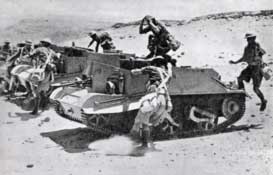 Some years later, in Odhams’ Modern Warfare, a second photo, at right, of upgraded Patt. ’08 showed a Patt. ’37 sized Haversack, on troops wearing Patt. ’08 in Egypt. As the book was published in wartime, it can only be assumed that these are T.A. troops. The important point was that the speculated “other” upgraded item was now proved to exist.
Some years later, in Odhams’ Modern Warfare, a second photo, at right, of upgraded Patt. ’08 showed a Patt. ’37 sized Haversack, on troops wearing Patt. ’08 in Egypt. As the book was published in wartime, it can only be assumed that these are T.A. troops. The important point was that the speculated “other” upgraded item was now proved to exist.
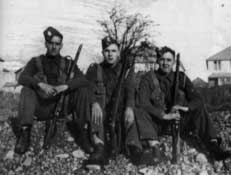 More recently, after Karkee Web went on-line, Allen Prior sent in the photo of 4th Bn. (T.A.) Welch Regiment, on Home Service in Haverfordwest, Pembrokeshire, each man wearing Patt. ’08 Basic pouches. This was the first clear photograph to show the Pouches in full. Photograph from The Welch Regiment (41st & 69th Foot) 1881-1969 compiled by Bryn Owen for theWelch Regt. Museum, published by Tempus Publishing, 1999. Provided to KW by Allen Prior.
More recently, after Karkee Web went on-line, Allen Prior sent in the photo of 4th Bn. (T.A.) Welch Regiment, on Home Service in Haverfordwest, Pembrokeshire, each man wearing Patt. ’08 Basic pouches. This was the first clear photograph to show the Pouches in full. Photograph from The Welch Regiment (41st & 69th Foot) 1881-1969 compiled by Bryn Owen for theWelch Regt. Museum, published by Tempus Publishing, 1999. Provided to KW by Allen Prior.
 The latest, in just these four photographs - across nearly 40 years - has come from Michael Skrilitz. He spotted a photo (Link) in a modelling forum and forwarded it to Karkee Web, querying what it exactly showed, i.e. might the Basic pouches be Utility pouches. It was clear that the Braces were Patt. ’08, which would not fit the 1.5-inch buckles of the U.P. What was of great interest, however, was the soldier – not a Territorial, but a soldier in the King’s African Rifles, wearing Patt. ’08 Basic pouches. The photo was taken in Ethiopia, which accounts for the Italian Beretta Modello 1938 across the European’s shoulder!
The latest, in just these four photographs - across nearly 40 years - has come from Michael Skrilitz. He spotted a photo (Link) in a modelling forum and forwarded it to Karkee Web, querying what it exactly showed, i.e. might the Basic pouches be Utility pouches. It was clear that the Braces were Patt. ’08, which would not fit the 1.5-inch buckles of the U.P. What was of great interest, however, was the soldier – not a Territorial, but a soldier in the King’s African Rifles, wearing Patt. ’08 Basic pouches. The photo was taken in Ethiopia, which accounts for the Italian Beretta Modello 1938 across the European’s shoulder!
Previously, no evidence had emerged of a Colonial unit in upgraded Patt. ’08. It begs the question of what other units may have been similarly equipped. The K.A.R. were by way of being the premier Colonial unit in East Africa, so it not surprising that funds were found to equip them. Readers – more information is required!!

 This was a standard Mark I, but fitted at just under half-height with a patch holding Hooks, brass, 3 inch. In place of the Buckle, brass, 1 inch, with loop (a 4-bar buckle) a new fitting was fitted, in order to accommodate the 2-inch wide ’08 Brace. The nomenclature of this new buckle (again 4-bar) is unknown, as it did not appear in Army Vocabularies. Extrapolating the Patt. ’37 term, it would be a Buckle, brass, 2 inch, with loop. The chape for this had to be correspondingly wider, so was in 4-inch webbing, folded in half, withthe edges folded in to create a waisted section for the buckle. The chape was then stitched into place, forming a wide fairlead, so that it functioned in exactly the way of a Pattern ’37 version. Closure, with a press fastener on a tab, was unchanged. The 1-inch wide loop on the buckle provided an identical connection for the Hook, brass, haversack, left, or -right fitted on the standard Patt. ’37 Straps, shoulder haversack. This example is maker marked "MW&S Ltd." and dated 1938. From the John Bodsworth Collection. Photographs © John Bodsworth 2012.
This was a standard Mark I, but fitted at just under half-height with a patch holding Hooks, brass, 3 inch. In place of the Buckle, brass, 1 inch, with loop (a 4-bar buckle) a new fitting was fitted, in order to accommodate the 2-inch wide ’08 Brace. The nomenclature of this new buckle (again 4-bar) is unknown, as it did not appear in Army Vocabularies. Extrapolating the Patt. ’37 term, it would be a Buckle, brass, 2 inch, with loop. The chape for this had to be correspondingly wider, so was in 4-inch webbing, folded in half, withthe edges folded in to create a waisted section for the buckle. The chape was then stitched into place, forming a wide fairlead, so that it functioned in exactly the way of a Pattern ’37 version. Closure, with a press fastener on a tab, was unchanged. The 1-inch wide loop on the buckle provided an identical connection for the Hook, brass, haversack, left, or -right fitted on the standard Patt. ’37 Straps, shoulder haversack. This example is maker marked "MW&S Ltd." and dated 1938. From the John Bodsworth Collection. Photographs © John Bodsworth 2012.
The photo at right, taken in April, 1940, shows a soldier in the 4th Btn., Devonshire Regt., wearing Patt. 1908 Basic pouches. From the Karl Vines Collection, photo © Karl Vines 2017.


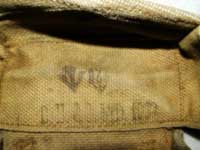 The few examples so far noted were not fitted with the triple ballistite cartridge loops inside the box lid. Whilst the ballistite loops are commonly seen on Canadian made Pouches, basic, they appear to have been discontinued in British production some time in 1938, based on evidence of locations of the markings. The markings on this example read "BH&G", 1939. The 4 bar buckle is here inverted, to show its novel format more clearly. This buckle had not been used in any other prior design, so had been created specially for this application. It is probably unlikely that a Mark II was ever created, moving the hook patch down by 1-inch, as was done with Patt. ’37. Similarly, a lengthened Mark III (to take Sten magazines) seems even more unlikely, but who knows?! From the Allen Prior Collection. Photographs © Allen Prior 2012.
The few examples so far noted were not fitted with the triple ballistite cartridge loops inside the box lid. Whilst the ballistite loops are commonly seen on Canadian made Pouches, basic, they appear to have been discontinued in British production some time in 1938, based on evidence of locations of the markings. The markings on this example read "BH&G", 1939. The 4 bar buckle is here inverted, to show its novel format more clearly. This buckle had not been used in any other prior design, so had been created specially for this application. It is probably unlikely that a Mark II was ever created, moving the hook patch down by 1-inch, as was done with Patt. ’37. Similarly, a lengthened Mark III (to take Sten magazines) seems even more unlikely, but who knows?! From the Allen Prior Collection. Photographs © Allen Prior 2012.
Haversack, W.E. Patt. ’08, large?
Haversack, W.E. Patt. ’37, modified?
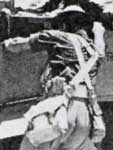 Both nomenclatures are speculative, as this also did not feature in Army Vocabularies. The “large” tag is inspired by the nomenclature used for the 3rd Issue Patt. ’58 W.E. Ammunition pouches. It would have been sufficiently discrete from the Haversack, W.E. Patt. ’08 and would have been a better nomenclature than tagging the Patt. ’37 Haversack as “modified”.
Both nomenclatures are speculative, as this also did not feature in Army Vocabularies. The “large” tag is inspired by the nomenclature used for the 3rd Issue Patt. ’58 W.E. Ammunition pouches. It would have been sufficiently discrete from the Haversack, W.E. Patt. ’08 and would have been a better nomenclature than tagging the Patt. ’37 Haversack as “modified”.
As part of the pre-war improvements, the Napoleonic era, tinned steel, Tin, mess, D.S. (Dismounted Services) had at last been superseded by Tins, mess, rectangular made in aluminium. One of the wizard wheezes was the idea that the Haversack should contain both this and the Water bottle in its Carrier. A larger Haversack was therefore designed, divided across its width, with a secondary divider from the centre of the main division to the centre front of the Haversack. The Mess tins went in the one front compartment and the Water bottle – inconveniently – into the other. In the one Haversack photo noted, one man still has his D.S. Mess tin, secured to the flap straps, Great War style!
 The identical design was used for Patt. ’08, but fitted on the side walls with Buckles, brass, 2 inch on chapes – the only change that was necessary. The base buckles and 2-inch tabs for the Haversack shoulder straps were unchanged. No example has yet come to light and only one photo has been noted. The Patt. ’08 Pack and old Haversack could have been attached in the old Patt. ’08 style, with sliding buckles on the Braces. However, there were now no “diagonal straps” to connect to the base buckles, this “counter strap” having been transferred to the loops on the sides of the handed Hooks, brass, haversack.
The identical design was used for Patt. ’08, but fitted on the side walls with Buckles, brass, 2 inch on chapes – the only change that was necessary. The base buckles and 2-inch tabs for the Haversack shoulder straps were unchanged. No example has yet come to light and only one photo has been noted. The Patt. ’08 Pack and old Haversack could have been attached in the old Patt. ’08 style, with sliding buckles on the Braces. However, there were now no “diagonal straps” to connect to the base buckles, this “counter strap” having been transferred to the loops on the sides of the handed Hooks, brass, haversack.
Carrier, entrenching tool, head
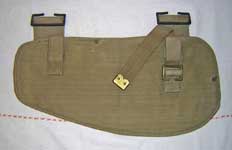
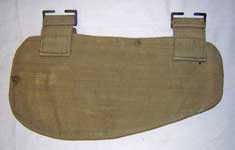
 This interesting variant is identical to the first issue Entrenching tool carrier issued withW.E. Patt. '37 , except that is has 2-inch buckled chapes instead of the 1-inch ones found on Pattern '37. The Implement, intrenching, Patt. ’08, was reintroduced by L. of C. §B5409 in 1941, as the Implement, entrenching, Patt. ’37, after having been declared obsolete in 1923. This Carrier, identical to the Patt. '37 except for the 2-inch buckles, would seem to be a logical requirement for troops still using W.E. Patt. '08. This example is maker marked "BAGCRAFT LTD." and dated 1941. From the Karkee Web Collection.
This interesting variant is identical to the first issue Entrenching tool carrier issued withW.E. Patt. '37 , except that is has 2-inch buckled chapes instead of the 1-inch ones found on Pattern '37. The Implement, intrenching, Patt. ’08, was reintroduced by L. of C. §B5409 in 1941, as the Implement, entrenching, Patt. ’37, after having been declared obsolete in 1923. This Carrier, identical to the Patt. '37 except for the 2-inch buckles, would seem to be a logical requirement for troops still using W.E. Patt. '08. This example is maker marked "BAGCRAFT LTD." and dated 1941. From the Karkee Web Collection.
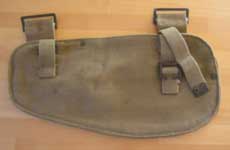
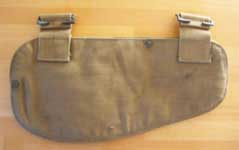
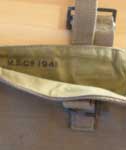 Another example, maker marked "M.E. Co." and dated 1941. From the Richard Knight Collection, photos © Richard Knight 2012.
Another example, maker marked "M.E. Co." and dated 1941. From the Richard Knight Collection, photos © Richard Knight 2012.
Rog Dennis, 2012